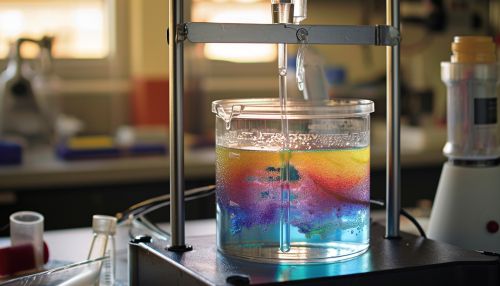Mass Transfer
Introduction
Mass transfer is a fundamental concept in the field of chemical engineering, physical chemistry, and thermodynamics. It involves the movement of physical quantities, often in the form of energy or particles, from one region to another. This process is driven by differences in concentrations, temperatures, or other driving forces.


Basics of Mass Transfer
Mass transfer is a phenomenon that involves the net movement of mass from one location, usually meaning a stream, phase, fraction, or component, to another. Mass transfer occurs in many processes, such as absorption, evaporation, drying, crystallization, and distillation.
The driving force for mass transfer is typically a difference in chemical potential, concentration, or temperature. When a system is in equilibrium, there is no net mass transfer. However, when a system is disturbed from equilibrium, mass transfer will occur to restore the system to equilibrium.
Types of Mass Transfer
Mass transfer can be classified into various types depending on the nature of the process.
Diffusion
Diffusion is a process that results from the random motion of molecules, leading to a net flow from regions of higher concentration to regions of lower concentration. This is the most common type of mass transfer and is driven by a concentration gradient.
Convection
Convection involves mass transfer through a fluid caused by the movement of the fluid itself. This can occur naturally due to density differences within the fluid, or it can be forced by external means, such as by a pump or fan.
Advection
Advection is a type of mass transfer that occurs when particles or quantities are carried along by a fluid flow. This is common in natural systems, such as rivers or winds, and in engineered systems, such as pipelines or ventilation systems.
Mass Transfer Coefficient
The mass transfer coefficient is a measure of how quickly mass transfer occurs in a particular system. It depends on the properties of the system, including the type of mass transfer (diffusion, convection, or advection), the properties of the substances involved, and the conditions under which the mass transfer occurs.
Applications of Mass Transfer
Mass transfer principles are applied in numerous industrial processes and natural phenomena. Some of the key applications include:
Chemical Industry
In the chemical industry, mass transfer is used in processes such as distillation, extraction, and absorption to separate and purify chemicals.
Environmental Engineering
In environmental engineering, mass transfer principles are used to understand and control the spread of pollutants in air, water, and soil.
Biomedical Engineering
In biomedical engineering, understanding of mass transfer is crucial for designing systems such as artificial kidneys and drug delivery devices.
